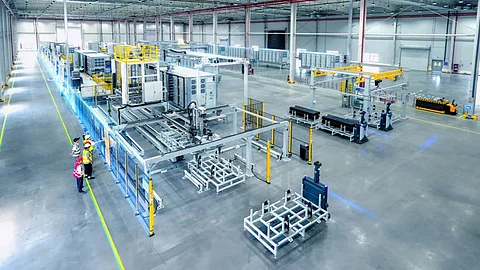

Trina Storage, the energy storage subsidiary of Trinasolar, has completed the upgrade of its smart integration factory in Chuzhou, Anhui Province. The company’s focus with this upgrade was to enhance production quality. According to Trina Storage, it has now automated key processes such as cell manufacturing, intelligent module assembly, and battery cabin integration and testing, increasing its automation rate by 23%. It adds that the upgrade has significantly strengthened the company’s industry-leading position, boosting overall production efficiency by 50% and testing efficiency by over 60%, thereby enhancing its capability for large-scale and high-standard deliveries.
Trina Storage announced in May that it was listed on BloombergNEF’s Tier 1 Energy Storage Manufacturer list for the 6th consecutive time.
On the subject of storage, China’s National Energy Administration announced last week that the country’s energy storage capacity increased by 29% from the end of 2024 in H1 2025 (see China's New Energy Storage Capacity Surges 29% in H1 2025).
Heterojunction (HJT) solar cell and module manufacturer Grand Sunergy is expanding into the perovskite tandem solar cell module sector and energy storage manufacturing. The company has signed an agreement with the local government of Tieling, Liaoning Province, to build a new energy industrial park with a total investment of RMB 3 billion ($416.67 million). According to local media Tieling Daily, the project will be implemented in 2 phases and will establish a complete industrial chain covering solid-state battery anode and cathode material production and recycling, cell manufacturing, and pack assembly. It will also include R&D and manufacturing of new technologies such as HJT-perovskite tandem cells and advanced equipment for the new energy sector. The project also explores integrated wind–solar–storage application scenarios, aiming to build a green industrial park.
Solar cell equipment manufacturer Shenzhen S.C New Energy has released its earnings forecast for the first half of 2025. The company expects to achieve a net profit attributable to shareholders of between RMB 1.7 billion ($236.11 million) and RMB 1.96 billion ($272.22 million), representing a year-on-year increase of 38.65% to 59.85% from RMB 1.226 billion ($170.28 million) in the same period last year. The company attributed the growth primarily to revenue recognition from completed and accepted orders during the period.
In April, Shenzhen S.C reported 116% YoY revenue growth for FY2024 and 58.95% for Q1 2025 (see China Solar PV News Snippets).
According to data released by China’s National Energy Administration (NEA), China added 211.61 GW of new solar PV capacity in the first half of 2025. This includes 98.8 GW of centralized PV (+99.19% YoY), 87.18 GW of commercial and industrial (C&I) PV (+61.7% YoY), and 25.63 GW of residential PV (+135.43% YoY). NEA attributes the surge across all segments to the Notice on Deepening Market-based Pricing Reform for Renewable Energy to Promote High-quality Development (also called Document No. 136) issued by NEA and NDRC in February 2025.
As of the end of June 2025, China’s cumulative installed PV capacity reached 1,098.51 GW, including 605.95 GW of centralized PV, 492.56 GW of C&I PV, and 179.66 GW of residential PV.
Despite predictions of a slowdown, China expects its 2025 solar PV installations to increase by 35.5% YoY (see China Forecasts 380 GW New Solar PV Installations In 2025).
